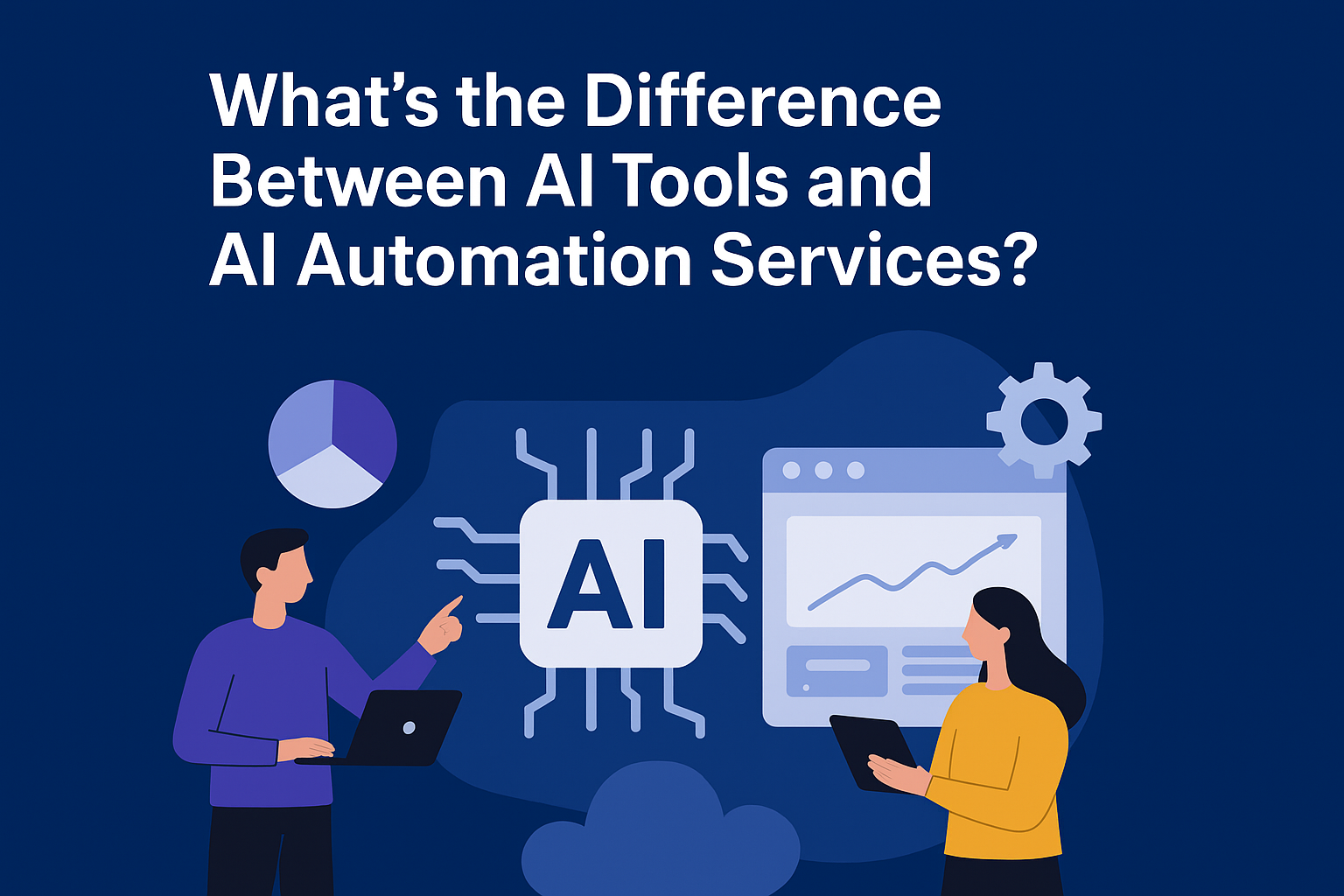
What Makes AI Tools Popular in Modern Workflows?
In today’s technology-driven landscape, businesses are increasingly drawn to AI-powered solutions that promise speed, efficiency, and precision. AI tools – whether for text generation, image recognition, data analysis, or customer interaction – have quickly become popular for their ability to handle specific, well-defined tasks.
These tools are designed with a narrow focus. A chatbot tool, for example, can manage customer conversations, while a data visualization tool can turn spreadsheets into actionable insights. Their popularity stems from being easy to adopt, often affordable, and user-friendly, making them accessible to companies of all sizes.
However, the challenge arises when organizations begin to rely on multiple tools simultaneously. Each operates in isolation, creating silos of information and processes. This fragmentation often reduces efficiency and limits scalability.
How Do AI Automation Services Take Things Further?
While AI tools address individual problems, AI automation services go a step further by weaving these tools into a seamless operational framework. An AI Automation Agency focuses not just on technology itself but on how it integrates into an organization’s ecosystem.
Automation services bring together AI models, business processes, and data pipelines into a cohesive system that functions with minimal human intervention. For example:
- In healthcare, automation services can unify patient record systems, AI-driven diagnostics, and scheduling platforms into a streamlined care delivery model.
- In construction, AI automation can coordinate supply chain data, workforce scheduling, and safety monitoring tools, ensuring projects stay on time and within budget.
- In e-commerce, automation connects inventory management, customer engagement, and personalized marketing into one synchronized flow.
The value lies in orchestration—turning individual tools into a unified solution that reduces manual effort and drives consistent results.
Why Is the Difference Between AI Tools and Automation So Important?
Understanding the distinction between AI tools and AI automation services is critical for long-term success. Businesses that only adopt tools may see short-term productivity boosts, but they often encounter scalability challenges as operations grow.
On the other hand, automation services focus on sustainability. They are not just about applying AI but about embedding intelligence into workflows. This ensures that organizations can:
- Scale operations without dramatically increasing costs.
- Reduce human error by standardizing processes.
- Free up teams to focus on higher-value, strategic tasks.
- Adapt quickly to new market demands or customer expectations.
In short, while tools solve immediate problems, automation services build future-ready infrastructures.
Who Benefits Most from AI Automation Services?
Different stakeholders within an organization benefit uniquely from automation:
- Executives gain reliable performance metrics and operational transparency.
- Managers experience smoother workflows and easier resource allocation.
- Employees are freed from repetitive tasks, allowing them to focus on creativity and problem-solving.
- Customers enjoy better service quality, faster response times, and personalized interactions.
Industries with complex, high-volume operations, such as finance, healthcare, retail, and manufacturing, see the most significant impact from automation. These sectors rely heavily on integrating multiple data streams and workflows, making them ideal candidates for AI automation services.
When Should a Business Transition From Tools to Automation?
The right time to move from standalone tools to comprehensive automation often depends on growth stage and complexity. Signs that a business is ready include:
- Rising manual workload: Teams spend more time managing tools than using them.
- Process bottlenecks: Data must be manually transferred between systems.
- Scalability limits: Tools cannot handle growing volumes without excessive human input.
- Customer demand: Clients expect faster, more seamless experiences than tools alone can provide.
For startups, tools can be a good starting point. But as operations scale, transitioning to automation services becomes essential for sustainable growth.
How Do AI Automation Agencies Deliver Long-Term Value?
An AI Automation Agency doesn’t simply implement tools; it redefines workflows. Agencies analyze business objectives, map existing processes, and design tailored solutions that bring multiple technologies together.
Key roles include:
- Strategic integration: Ensuring tools talk to one another within existing systems.
- Customization: Designing solutions unique to each industry and business model.
- Support and scalability: Offering ongoing service so solutions evolve with business needs.
- Measurement: Establishing benchmarks to track ROI, efficiency, and customer outcomes.
This approach ensures that businesses are not just using AI but are leveraging it in ways that directly impact growth, profitability, and long-term sustainability.
Visualizing the Difference
| Feature | AI Tools | AI Automation Services |
| Scope | Task-specific | Organization-wide |
| Integration | Standalone | Unified ecosystem |
| Scalability | Limited | High |
| Human Involvement | Moderate to high | Minimal |
| Impact | Short-term efficiency | Long-term transformation |
| Examples | Chatbots, analytics dashboards | End-to-end automated workflows |
Reflecting on the Future of AI Automation
The future belongs to businesses that move beyond fragmented tools and embrace automation as a strategic advantage. As industries evolve, automation services will not only enhance efficiency but also redefine customer expectations and competitive standards.
By partnering with an AI Automation Agency like Product Siddha, organizations can transform their operations into intelligent, scalable systems built for the challenges of tomorrow.
